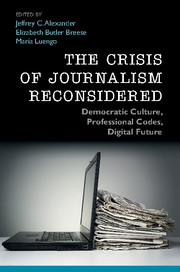Book contents
- Frontmatter
- Dedication
- Contents
- About the Contributors
- Preface
- Acknowledgments
- Introduction: Journalism, democratic culture, and creative reconstruction
- PART I THE CRISIS NARRATIVE
- 1 The perpetual crisis of journalism: Cable and digital revolutions
- 2 The crisis of public service broadcasting reconsidered: Commercialization and digitalization in Scandinavia
- 3 Beyond administrative journalism: Civic skepticism and the crisis in journalism
- 4 The many crises of Western journalism: A comparative analysis of economic crises, professional crises, and crises of confidence
- 5 The crisis in news: Can you whistle a happy tune?
- PART II FEARS OF DIGITAL NEWS MEDIA: THE SYMBOLIC STRUGGLE
- PART III PROFESSIONAL JOURNALISM, CIVIL CODES, AND DIGITAL CULTURE
- Conclusion: News innovations and enduring commitments
- Index
- References
1 - The perpetual crisis of journalism: Cable and digital revolutions
from PART I - THE CRISIS NARRATIVE
Published online by Cambridge University Press: 05 June 2016
- Frontmatter
- Dedication
- Contents
- About the Contributors
- Preface
- Acknowledgments
- Introduction: Journalism, democratic culture, and creative reconstruction
- PART I THE CRISIS NARRATIVE
- 1 The perpetual crisis of journalism: Cable and digital revolutions
- 2 The crisis of public service broadcasting reconsidered: Commercialization and digitalization in Scandinavia
- 3 Beyond administrative journalism: Civic skepticism and the crisis in journalism
- 4 The many crises of Western journalism: A comparative analysis of economic crises, professional crises, and crises of confidence
- 5 The crisis in news: Can you whistle a happy tune?
- PART II FEARS OF DIGITAL NEWS MEDIA: THE SYMBOLIC STRUGGLE
- PART III PROFESSIONAL JOURNALISM, CIVIL CODES, AND DIGITAL CULTURE
- Conclusion: News innovations and enduring commitments
- Index
- References
Summary
The crisis of journalism in the United States is a perpetual crisis. Current articulations of crisis claim that the digital era introduces new and urgent problems to journalism. The crisis of American journalism is articulated through a narrative of decline that warns that the future of journalism will be worse than the past. However, the discourse of crisis and grave doubts about the future of professional journalism are not new. Today and in previous eras, the past seems to represent the high mark of professional journalism in the United States, and the future of the news seems exceptionally uncertain.
New technologies and developments in journalism seem to threaten to put an end to newspapers (Meyer 2009; Alterman 2011; Shirky 2011; see Bissinger 2012), to do away with the traditional role of the “reporter” (McChesney and Pickard 2011), and even to threaten the end of journalism in our time. Recent manuscripts, including Losing the News (Jones 2009), What is Happening to the News (Fuller 2010), Can Journalism Be Saved? (Mersey 2010), and The Vanishing Newspaper (Meyer 2009), impart the stark impression that journalism as we know it is on the brink.
My purpose is to make sense of these claims of the crisis of journalism and the end of journalism in cultural and historical terms, showing that these claims draw upon and sustain longstanding interpretive patterns of the news. This study illuminates the organization of the meaning system of the news that individuals use to construct meaning from experience. I seek to explain cultural structures that organize continual concerns that journalism deteriorates, rather than improves, over time and to describe the organizing power of these discourses. When journalism encounters new technologies, new media, and newcomers, the disruptions are narrated as threats to journalistic standards and the ability of journalism to convey the news. Rather than being welcomed as sustaining and improving journalism, new innovations and newcomers to the journalistic field are regularly interpreted as detriments. These interpretations of threats, I will show, serve to reinforce the longstanding codes and standards of professional news in the United States.
This chapter examines how three newcomers to journalism of different sorts – a person, a media, and a communication technology – were described as symptomatic of the decline and crisis of American journalism.
- Type
- Chapter
- Information
- The Crisis of Journalism ReconsideredDemocratic Culture, Professional Codes, Digital Future, pp. 31 - 42Publisher: Cambridge University PressPrint publication year: 2016
References
- 6
- Cited by

